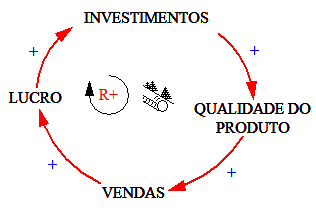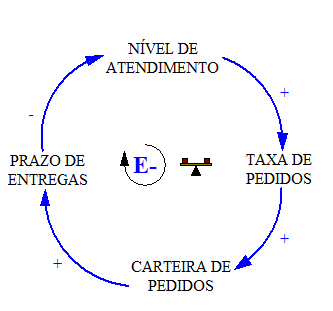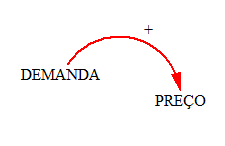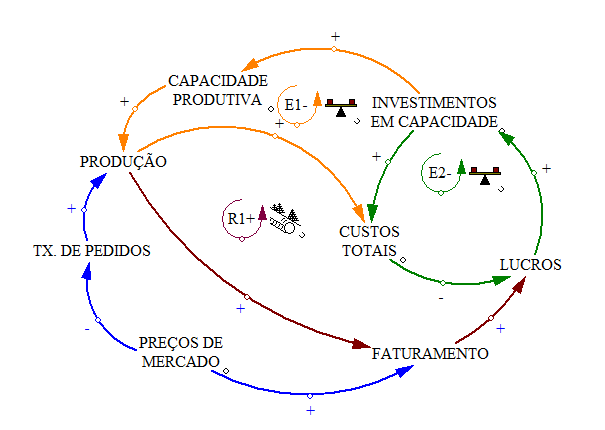“The feedback loop, also known as feedback loop., is a methodology that visually identifies the cause and effect relationships of a company's processes and thus provides a systemic view of the business. It can be used when managers need to make important decisions for the future, reducing the chances of error and making the decision-making process more assertive.“
THE feedback loop, also known as feedback loop., is a methodology that visually identifies the cause and effect relationships of a company's processes and thus provides a systemic view of the business.
When managers need to make important decisions for the future of their business, ideally, these decisions are made based on as much information as possible.. In this way, it is possible to reduce the chances of error and thus make more assertive decisions.
In this article you will understand how the feedback loop can help just at this point.. Let's talk about:
- What is the feedback loop;
- what are its benefits;
- How to do a feedback loop;
- Practical example.
That way you can put it into practice in your factory and achieve valuable benefits, for example:
- Identify virtuous cycles and expand them;
- Identify vicious cycles and optimize them;
- Make more assertive decisions;
- Have a more systemic view of the factory's operation.
What is the feedback cycle
Feedback cycles are cause-and-effect relationships that directly impact the dynamics of systems, that is, is a sequence of variables that are interrelated in a loop..
The feedback loop is represented by a cause-effect diagram, which uses arrows to show the relationships of the variables most relevant to the system.
There are two types of feedback: Reinforcement and Balance.
Reinforcement feedback
Reinforcement feedback has positive polarity and is responsible for reinforcing or expanding the system's initial action. Besides that, there are two types of reinforcing feedback:
Virtuous Cycle: occurs when there is an exponential growth of the variables.
Vicious cycle: defined by a decline of the variables.

Balance feedback
On the other hand, balancing feedback tends to oppose initial action seeking to stabilize complex systems. The polarity of this feedback is negative.

What are the benefits of the feedback loop
The feedback cycle is a methodology whose main benefit is to assist managers in developing a systemic view of the business, through variables that are related over time.
Thus, it is possible to analyze how a new variable interferes in the system or if the actions that have already been implemented have undergone any changes.
Besides that, diagrams help identify vicious cycles that impede growth, as well as virtuous cycles that must be expanded according to the company's viability. In addition to identifying relevant variables/actions to create indicators, internal policies and propose increasingly effective improvements.
These benefits end up generating other indirect advantages for the company, What:
- Improved decision making;
- Cost and waste reduction;
- Increased overall productivity;
- Non-profit increase.
How to cycle feedback
Now, let's learn step-by-step to create a causal relationship diagram and identify feedback loops.
1Step: Identify the variables relevant to the system
The first thing to do to create the cause and effect diagram is to identify the variables/actions that impact your business. Examples: Demand, Delivery fee, Profit, Costs, Prices, etc.
2Step: Identify causal relationships and polarity
With the relevant variables defined, the next step is to see what are the cause and effect relationships between them. This relationship is defined by an arrow that connects the variables.
For example: Demand has a direct relationship to price. when demand increases, the price also increases. Logo, this causal relationship has positive polarity.

3Step: Identify and classify feedback loops
After placing all the cause and effect relationships and their respective polarities, we can identify the closed loops in the diagram. Then, we can classify them into:
- Reinforcement Feedback:
- Virtuoso: When all polarities are positive
- Vicious: When all polarities are negative or have an even number of negative polarities
- Balance Feedback: When the total number of negative polarities are odd.
For you to understand better, See the following example.
Example of diagrams with feedback loop
A company would like to assess what is the risk of investing in productive capacity. To broaden your perception of this issue, a causal diagram was constructed with the following feedback loops.

According to the diagram, it is possible to notice that they were identified 3 feedback cycles: Two balancing cycles and one boosting cycle, are they:
Balance Feedback (E1-): When we invest in capacity, there is an increase in Productive Capacity and Production. meantime, we will have an increase in total costs and consequently profits will be reduced.
Balance Feedback (E2-): The investment in capacity generates an increase in total costs and lower profits. when profit increases, we have more cash to invest in capacity to meet demand. Besides that, as we only have one negative polarity, we have a balance feedback.
Reinforcement Feedback (R1 +): This feedback reinforces the idea that if there is an increase in Investments in capacity, there is also an increase in productive capacity, production, billing and profits. Besides that, the R1+ feedback is virtuous, because all your polarities are positive.
Software to create your diagram
Now that you've learned what it is, how it works and how to assemble your cause and effect diagram with the feedback loop, just get your hands dirty and carry out the analyzes with the most relevant variables for your company.
To make your daily life easier, use a software that allows you to assemble the diagram more easily, after all, our time is precious. A good option is Vensim, an industrial performance simulation software that has a free trial for you to start your analysis.
Link para download: https://vensim.com/download/
- This article was removed from the site: Nomus

To understand how to Scooter can help your industry and learn about our projects, contact from the site (click here), fur e-mail daniel@taygahs.com or at phone and Whatsapp (21) 9.8819-3687
It will be a pleasure to get to know your business and help with our customized energy efficiency solutions!
We also recommend reading our materials on the heating and insulation systems implemented by Tayga (just click and you will be redirected):


